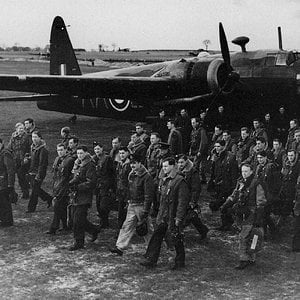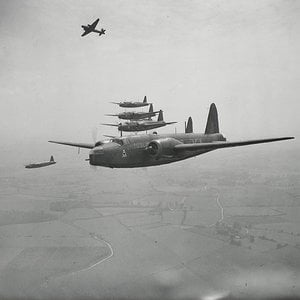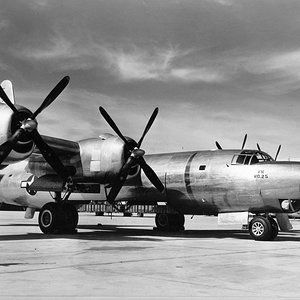Navigation
Install the app
How to install the app on iOS
Follow along with the video below to see how to install our site as a web app on your home screen.
Note: This feature may not be available in some browsers.
More options
You are using an out of date browser. It may not display this or other websites correctly.
You should upgrade or use an alternative browser.
You should upgrade or use an alternative browser.
The Petlyakov PE-8.
The Petlyakov Pe-8 was a Soviet heavy bomber designed before World War II, and the only four-engine bomber the USSR built during the war. Produced in limited numbers, it was used to bomb Berlin in August 1941. It was also used for so-called "morale raids" designed to raise the spirit of the Soviet people by exposing Axis vulnerabilities. Its primary mission, however, was to attack German airfields, rail yards and other rear-area facilities at night, although one was used to fly the People's Commissar of Foreign Affairs (Foreign Minister) Vyacheslav Molotov from Moscow to the United States in 1942.
Originally designated the TB-7, the aircraft was renamed the Pe-8 after its primary designer, Vladimir Petlyakov, died in a plane crash in 1942. Supply problems complicated the aircraft's production and the Pe-8s also had engine problems. As Soviet morale boosters, they were also high-value targets for the Luftwaffe's fighter pilots. The loss rate of these aircraft, whether from mechanical failure, friendly fire, or combat, doubled between 1942 and 1944.
By the end of the war, most of the surviving aircraft had been withdrawn from combat units. After the war, some were modified as transports for important officials, and a few others were used in various Soviet testing programs. Some supported the Soviet Arctic operations until the late 1950s.
Development of the Pe-8 began in July 1934, when the Soviet Air Forces (VVS) issued requirements for an aircraft to replace the obsolete and cumbersome Tupolev TB-3 heavy bomber. These requirements specified a bomber that could carry 2,000 kg (4,400 lb) of bombs 4,500 km (2,800 mi) at a speed greater than 440 km/h (270 mph) at an altitude of 10,000 metres (32,808 ft), figures that were twice the range, speed and service ceiling of the TB-3. The task was assigned to the Tupolev Design Bureau (OKB) where Andrei Tupolev handed the work to a team led by Vladimir Petlyakov and the project received the internal bureau designation of ANT-42. The resulting aircraft, a four-engined, mid-wing cantilever monoplane, was initially designated as the TB-7 (Russian: Тяжёлый Бомбардировщик, Tyazholy Bombardirovschik—Heavy Bomber) by the VVS and owed more to the streamlined design of the Tupolev SB than to the block-like design of the TB-3.
The bomber was built mainly of duralumin, with two steel spars in the wings, although the ailerons were fabric-covered. The pear-shaped monocoque fuselage required the pilots to sit in tandem, offset to the left. In the prototype, space for a fifth engine, an auxiliary Klimov M-100, was reserved inside the fuselage, in a fairing above the wing spars and behind the pilots. It was intended to drive a supercharger that supplied pressurized air to the Mikulin AM-34FRN engines, with the installation designated ATsN-2 (Russian: Agregat tsentral'novo nadduva—Central Supercharging Unit). Subsequent models omitted the internal engine, and provided seating for a flight engineer and radio operator, behind and below the pilots. The bombardier sat in the nose and manned a turret armed with a 20-millimeter (0.79 in) ShVAK cannon that covered a 120° cone ahead. A prominent chin gondola, nicknamed the 'beard', protruded beneath the nose. The dorsal gunner sat at the rear of the ATsN fairing with a sliding hood covering a 7.62-millimeter (0.300 in) ShKAS machine gun and another ShKAS mounted in a ventral hatch. The tail gunner had a powered turret with a ShVAK and, most unusually, there were manually operated ShVAK cannon mounted at the rear of each inner engine nacelle. Crewmen had access to these positions through the wing or by a trapdoor in the upper wing surface. The large internal bomb bay racks held up to 4,000 kg (8,800 lb) of bombs; external racks held a single 500-kilogram (1,100 lb) FAB-500 bomb under each wing.
The maiden flight of the unarmed prototype, piloted by M. M. Gromov and without the ATsN installation, occurred at Khodynka Aerodrome on 27 December 1936.[6] After successful initial trials, the ATsN system was installed for the State acceptance trials in August 1937 and the AM-34RNB engines were fitted during the tests.Gromov reported that the rudder was ineffective and that the outer engines overheated. Subsequent wind tunnel testing identified a problem with the aerodynamics of the radiators and nacelles. To solve this problem, the outer engines' radiators were moved into deep ducts under the inner nacelles and the rudder was enlarged and redesigned with a smooth skin.
Construction of a second prototype began in April 1936, incorporating lessons from the first aircraft and feedback from the VVS. Designers widened the fuselage by 100 mm (3.9 in); the 'beard' was also widened and the tail section was modified to lessen resistance and improve rudder function. A reconfigured control system included an autopilot and the engineers redesigned portions of the electrical system. The engines were changed to the more powerful AM-34FRNVs and a redesigned undercarriage was fitted to the airframe. Two additional fuel tanks increased the craft's range. The defensive and offensive armament was revised, and the bomber's weaponry expanded to twin ShKAS guns in the nose, nacelle and tail turrets and a dorsal turret with a ShVAK; this design eliminated the ventral gun. The bomb bay was modified to allow for a single 5,000-kilogram (11,000 lb) FAB-5000 bomb to be carried and provisions were added to carry VAP-500 or VAP-1000 poison gas dispensers under the wings.
The arrests of both Tupolev and Petlyakov in October 1937, during the Great Purge, disrupted the program and the second prototype did not make its first flight until 26 July 1938.[9] Although this prototype served as the basis for the series aircraft, further modifications were made to the armament. New weaponry included a retractable ShVAK in the MV-6 dorsal turret, another ShVAK in a KEB tail turret and a 12.7-millimeter (0.50 in) Berezin UBT machine gun in each ShU barbette in each inner engine nacelle. Another fuel tank further increased the range, and the 'beard' was removed entirely, replaced by a more streamlined nose. Authorization for production was slow for several reasons, including the Great Purge, but also due to the scarcity of resources, and a shortage of workers. Although production facilities in the Kazan Factory No. 124 were ready as early as 1937, the order to begin was not given until 1939.
[edit] Manufacture and supply problemsEngine supply problems complicated the construction of the aircraft. Production of the ATsN superchargers could not be organized in any systematic way and only the first four Pe-8s were equipped with them. Factory No. 124 shut down its Pe-8 production line at the beginning of 1940 while alternative engines were evaluated. Somewhere in the massive Soviet chain of command, the decision was made to proceed without the superchargers. The unavailability of the Klimov M-100 engine of the ATsN-2 installation required a design change, although this modification allowed a commander and radio operator to be carried in its place. Then, to compound the problem further, the production of AM-34FRNV engines ended in the second half of 1939. Only two or four Pe-8s were equipped with them. Eighteen of the aircraft produced by the end of 1940 were fitted with AM-35A engines.
www.youtube.com/watch?v=iaguVXizkdw
The Petlyakov Pe-8 was a Soviet heavy bomber designed before World War II, and the only four-engine bomber the USSR built during the war. Produced in limited numbers, it was used to bomb Berlin in August 1941. It was also used for so-called "morale raids" designed to raise the spirit of the Soviet people by exposing Axis vulnerabilities. Its primary mission, however, was to attack German airfields, rail yards and other rear-area facilities at night, although one was used to fly the People's Commissar of Foreign Affairs (Foreign Minister) Vyacheslav Molotov from Moscow to the United States in 1942.
Originally designated the TB-7, the aircraft was renamed the Pe-8 after its primary designer, Vladimir Petlyakov, died in a plane crash in 1942. Supply problems complicated the aircraft's production and the Pe-8s also had engine problems. As Soviet morale boosters, they were also high-value targets for the Luftwaffe's fighter pilots. The loss rate of these aircraft, whether from mechanical failure, friendly fire, or combat, doubled between 1942 and 1944.
By the end of the war, most of the surviving aircraft had been withdrawn from combat units. After the war, some were modified as transports for important officials, and a few others were used in various Soviet testing programs. Some supported the Soviet Arctic operations until the late 1950s.
Development of the Pe-8 began in July 1934, when the Soviet Air Forces (VVS) issued requirements for an aircraft to replace the obsolete and cumbersome Tupolev TB-3 heavy bomber. These requirements specified a bomber that could carry 2,000 kg (4,400 lb) of bombs 4,500 km (2,800 mi) at a speed greater than 440 km/h (270 mph) at an altitude of 10,000 metres (32,808 ft), figures that were twice the range, speed and service ceiling of the TB-3. The task was assigned to the Tupolev Design Bureau (OKB) where Andrei Tupolev handed the work to a team led by Vladimir Petlyakov and the project received the internal bureau designation of ANT-42. The resulting aircraft, a four-engined, mid-wing cantilever monoplane, was initially designated as the TB-7 (Russian: Тяжёлый Бомбардировщик, Tyazholy Bombardirovschik—Heavy Bomber) by the VVS and owed more to the streamlined design of the Tupolev SB than to the block-like design of the TB-3.
The bomber was built mainly of duralumin, with two steel spars in the wings, although the ailerons were fabric-covered. The pear-shaped monocoque fuselage required the pilots to sit in tandem, offset to the left. In the prototype, space for a fifth engine, an auxiliary Klimov M-100, was reserved inside the fuselage, in a fairing above the wing spars and behind the pilots. It was intended to drive a supercharger that supplied pressurized air to the Mikulin AM-34FRN engines, with the installation designated ATsN-2 (Russian: Agregat tsentral'novo nadduva—Central Supercharging Unit). Subsequent models omitted the internal engine, and provided seating for a flight engineer and radio operator, behind and below the pilots. The bombardier sat in the nose and manned a turret armed with a 20-millimeter (0.79 in) ShVAK cannon that covered a 120° cone ahead. A prominent chin gondola, nicknamed the 'beard', protruded beneath the nose. The dorsal gunner sat at the rear of the ATsN fairing with a sliding hood covering a 7.62-millimeter (0.300 in) ShKAS machine gun and another ShKAS mounted in a ventral hatch. The tail gunner had a powered turret with a ShVAK and, most unusually, there were manually operated ShVAK cannon mounted at the rear of each inner engine nacelle. Crewmen had access to these positions through the wing or by a trapdoor in the upper wing surface. The large internal bomb bay racks held up to 4,000 kg (8,800 lb) of bombs; external racks held a single 500-kilogram (1,100 lb) FAB-500 bomb under each wing.
The maiden flight of the unarmed prototype, piloted by M. M. Gromov and without the ATsN installation, occurred at Khodynka Aerodrome on 27 December 1936.[6] After successful initial trials, the ATsN system was installed for the State acceptance trials in August 1937 and the AM-34RNB engines were fitted during the tests.Gromov reported that the rudder was ineffective and that the outer engines overheated. Subsequent wind tunnel testing identified a problem with the aerodynamics of the radiators and nacelles. To solve this problem, the outer engines' radiators were moved into deep ducts under the inner nacelles and the rudder was enlarged and redesigned with a smooth skin.
Construction of a second prototype began in April 1936, incorporating lessons from the first aircraft and feedback from the VVS. Designers widened the fuselage by 100 mm (3.9 in); the 'beard' was also widened and the tail section was modified to lessen resistance and improve rudder function. A reconfigured control system included an autopilot and the engineers redesigned portions of the electrical system. The engines were changed to the more powerful AM-34FRNVs and a redesigned undercarriage was fitted to the airframe. Two additional fuel tanks increased the craft's range. The defensive and offensive armament was revised, and the bomber's weaponry expanded to twin ShKAS guns in the nose, nacelle and tail turrets and a dorsal turret with a ShVAK; this design eliminated the ventral gun. The bomb bay was modified to allow for a single 5,000-kilogram (11,000 lb) FAB-5000 bomb to be carried and provisions were added to carry VAP-500 or VAP-1000 poison gas dispensers under the wings.
The arrests of both Tupolev and Petlyakov in October 1937, during the Great Purge, disrupted the program and the second prototype did not make its first flight until 26 July 1938.[9] Although this prototype served as the basis for the series aircraft, further modifications were made to the armament. New weaponry included a retractable ShVAK in the MV-6 dorsal turret, another ShVAK in a KEB tail turret and a 12.7-millimeter (0.50 in) Berezin UBT machine gun in each ShU barbette in each inner engine nacelle. Another fuel tank further increased the range, and the 'beard' was removed entirely, replaced by a more streamlined nose. Authorization for production was slow for several reasons, including the Great Purge, but also due to the scarcity of resources, and a shortage of workers. Although production facilities in the Kazan Factory No. 124 were ready as early as 1937, the order to begin was not given until 1939.
[edit] Manufacture and supply problemsEngine supply problems complicated the construction of the aircraft. Production of the ATsN superchargers could not be organized in any systematic way and only the first four Pe-8s were equipped with them. Factory No. 124 shut down its Pe-8 production line at the beginning of 1940 while alternative engines were evaluated. Somewhere in the massive Soviet chain of command, the decision was made to proceed without the superchargers. The unavailability of the Klimov M-100 engine of the ATsN-2 installation required a design change, although this modification allowed a commander and radio operator to be carried in its place. Then, to compound the problem further, the production of AM-34FRNV engines ended in the second half of 1939. Only two or four Pe-8s were equipped with them. Eighteen of the aircraft produced by the end of 1940 were fitted with AM-35A engines.
www.youtube.com/watch?v=iaguVXizkdw








